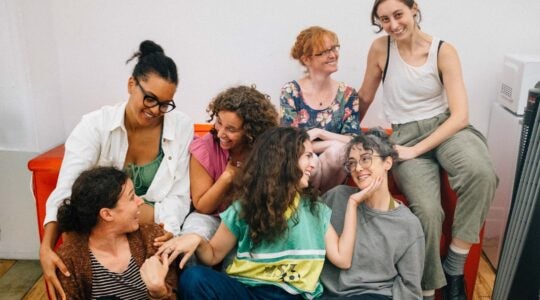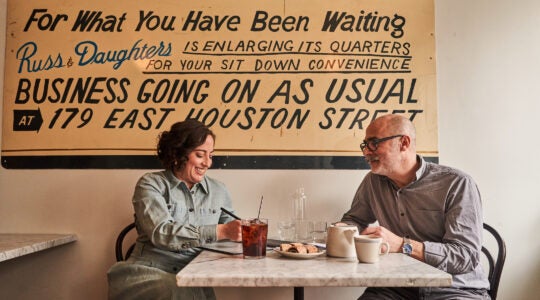As more than 900,000 New York City public school students enter their second full week of school, they have lots of learning to look forward to, including new lessons that focus on American Jews’ contributions to the history of the United States.
A nearly 300-page curricular supplement, “Hidden Voices: Jewish Americans in United States History, Volume 1,” aims to educate students in kindergarten through 12th grade about who the Jewish people are, beyond what they might know about the Holocaust and European Jewry.
The new resource, which is available to all New York City public school teachers, is the result of a nearly two-year collaboration between the Jewish Community Relations Council of New York, an advocacy group, and the New York City Department of Education.
“We have to make sure that students understand that the Jewish community is more than just a faith-based group — that [it] is an ethnic group, that they have an origin story,” said Mark Treyger, CEO of the JCRC and a former high school history teacher. “And also, the Jewish community is not new to New York and American life, and that they have positively contributed to New York and American life.”
The curriculum supplement has lessons that span many decades, from the colonial era through the labor union movements of the early 1910s. It spotlights New York Jewish luminaries like poet Emma Lazarus and newspaper magnate Joseph Pulitzer, as well as to lesser-known American Jews like Philadelphia’s Rabbi Isaac Leeser, who was credited with starting the Jewish Sunday school, and New York socialite Bilhah Abigail Levy Franks, whose letters have helped historians understand what it was like to live as an assimilated Jew in New York in the 1700s.
This Jewish-centered resource is part of the Hidden Voices Project, which the Department of Education initiated in 2018. The project aims to provide educational materials on groups underrepresented in American history, including the LGBTQ+ community, the Asian community and the Black and African diaspora communities. Earlier this year, the DOE published “Hidden Voices: Muslim Americans in United States History” and “Hidden Voices: Latines in United States History.”
The Hidden Voices Project is not a mandatory part of the city’s public school curriculum. Rather, it supplements the city’s Passport to Social Studies curriculum, which meets Common Core and New York State K-8 standards.
Treyger said the decision to expand the project to include Jewish Americans was catalyzed partly by the tense environment in New York after the Oct. 7 Hamas attack on Israel, including a November 2023 incident in which a Jewish teacher in Queens was harassed by students over her participation in a pro-Israel rally.
Nonetheless, the focus of the Jewish American curriculum supplement is not antisemitism.
“Unfortunately, a lot of times when Jewish stories are told, it’s about acts of antisemitism,” said Brian Carlin, the DOE’s director of social studies. “That’s not what we want it to be. We want it to be how Jews and other groups always contribute to American society, economics, sociopolitical, cultural. So that’s the beauty of Hidden Voices. It gives a teacher these resources and information and ways that they can think about how they include it when you’re teaching history.”
The supplement includes primary sources and guiding questions for teachers, as well as suggestions for educators on how to support their Jewish students — including a note on making sure not to single out students for their beliefs on Israel, or making them feel responsible for the actions of the Israeli government.
“For a healthy social emotional environment, it is important to create spaces for students to share their experiences and feelings,” the resource says. “From a social studies disciplinary thinking perspective, it is also important for students to study the evidence of harm and associated data, such as the prevalence of hate incidents, and analyze their effects.”
There’s also a map with significant places in New York City’s Jewish history — such as Ellis Island and the childhood home of Ruth Bader Ginsburg — and contextualizes Jewish influence in broader American history.
It also defines Zionism as “The right to Jewish national self-determination in their ancestral homeland.” It continues: “Zionism as a movement emerged in the late nineteenth century during a time of rising nationalism across the globe and widespread antisemitism across Europe.”
The curricular supplement will be piloted in a yet-to-be-determined number of schools this semester, according to Carlin. Teachers at the participating schools will have some professional development around the curricular supplement, participate in focus groups, and provide feedback to the education department.
To create the resource, the JCRC and the DOE collaborated with multiple institutions, including the American Jewish Historical Society, Columbia University Libraries, the National Council of Jewish Women, the National Archives, UJA-Federation of New York, the Library of Congress, and dozens of other groups.
For Treyger, teaching public school students about who the Jews are is part of a broader mission to combat hate in all its forms.
“Our hope is that this will get this will grow, and this will get scaled, and in a very meaningful way that’s sensitive to our community, and also to the needs of our school community, to combat not just antisemitism, but to combat just complete the impact of propaganda from social media — a lot of ignorance out there,” Treyger said.
“Hidden Voices: Jewish Americans, Volume 2” is scheduled to be released in the spring semester, and will focus on Americans who are well-known but whose Jewish identities are less prominent.
“We want to tell stories that people don’t know about,” Carlin said. “That’s why they’re hidden, right?”
The New York Jewish Week brings you the stories behind the headlines, keeping you connected to Jewish life in New York. Help sustain the reporting you trust by donating today.




